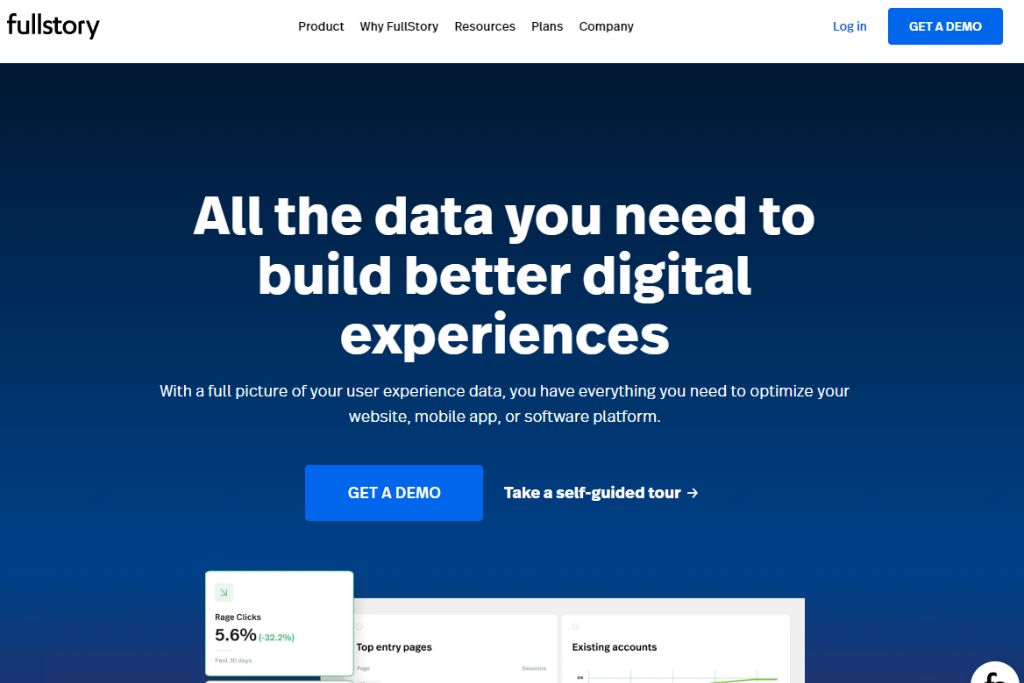Table of Contents
Do you want to learn about new and innovative tools that can help you learn more about the people who visit your website? How can you learn more about how people use your website to improve its performance?
In the digital age, we live in now, shoppers and website owners are always looking for alternatives to Hotjar, a famous tool for analyzing websites. But why do they want to find other options?
Hotjar has been the go-to tool for knowing how users behave, with features like heatmaps, session recordings, and surveys. But as technology changes, so do the things that website owners and marketers expect from each other.
In simpler terms, these alternatives to Hotjar are like exciting new choices in a game. They give website owners new ways to learn about their users and improve their online presence. Just as each player in a match has their skills, each competitor in website analytics has unique features and benefits.
What is Hotjar?
 Source: Hotjar
Source: Hotjar
Hotjar is a powerful and flexible tool used by many people, such as website owners, marketers, and people who work in user experience. It helps them learn important things about how people use their websites and how they connect with them.
This tool solves several problems and challenges that website owners and marketers face. One common problem is figuring out why people leave a website or don’t do things like purchase or fill out a form.
Hotjar has a free plan with restricted features and paid plans with more advanced features. Its unique value comes from the wide range of tools built into a single platform. These tools include heatmaps, session recordings, polls, and feedback.
What is Hotjar Used For?
Hotjar is a unique tool that helps website owners understand how people behave and interact with their websites. It’s like having a detective investigating what visitors do when visiting a website.
Heatmaps show website owners which parts of a webpage get the most attention, like which buttons or links people click on the most. Session recordings let website owners watch videos of how people move around and use their websites.
Using Hotjar, website owners can learn what visitors like, what they don’t like, and how to make their websites even better to give visitors a fantastic experience.
Key Features and Functionalities of Hotjar
Hotjar provides strong tools to assist website owners in understanding visitor behavior and optimizing their sites. It offers many options to improve the user experience, including heatmaps, session records, and surveys.
Hotjar’s main features and functions include:
Heatmaps
Hotjar’s heatmaps visually represent user interactions on a webpage, showing which areas receive the most attention. This helps website owners identify popular sections, optimize their design, and improve user engagement.
Surveys and Feedback
These tools allow website owners to ask visitors questions to understand their opinions and suggestions. It helps make websites more enjoyable for users by listening to their ideas.
Session Recordings
Hotjar records and plays back how users move around a website. This helps website owners see what visitors do and find easier ways to make their websites.
Conversion Funnels
Hotjar’s conversion funnels track user journeys and identify where visitors drop off in the conversion process. This helps website owners identify bottlenecks and optimize their funnels for better conversion rates.
Form Analytics
These tools help website owners understand if there are any problems with forms, like when people need help filling them out. This way, website owners can fix the issues and make it easier for users.
Visitor Recordings
Hotjar records and shows website owners how individual users move and click on a website. It helps website owners see how people use their websites and make changes to make them better.
Behavior Analytics
It tells website owners how people use their sites, like what they click on and how long they stay on each page. This information helps the people who run the websites figure out what their users like so they can make their sites more engaging.
User Feedback and Polls
With Hotjar, website owners can use surveys and polls to determine people’s thoughts about their sites. It helps people who run websites get tips from users on improving their sites.
Mobile Analytics
This service provides insight into how visitors engage with websites from mobile devices. Webmasters can ensure their sites’ compatibility with mobile devices in this way.
User Recruiters
This feature acts as a user recruiter, assisting website owners in locating individuals willing to test and provide feedback on their sites. Finding skilled professionals to improve websites is simplified as a result.
What are the Benefits of Hotjar?
-
Understand what people like: Hotjar tells the people who own websites which parts of their sites people like best. Knowing what people want about their website helps them make it better.
-
Make websites easier to use: Hotjar lets website managers see what visitors do on their sites, which makes them easier to use. This helps make websites easier to use.
-
Listen to visitor opinions: With Hotjar, site owners can ask website users for feedback. This makes websites easier to use by listening to and acting on what users say.
-
Improve sales and conversions: Hotjar watches how people on a website buy things or finish chores. This helps to increase sales and conversions. It helps website owners figure out where customers get stuck so they can fix it and make more sales.
-
Create a better user experience: To improve the user experience, Hotjar shows where users click and scroll.
Overall, Hotjar helps website owners learn more about their visitors, make their websites easier to use, get comments, increase conversions, and give users a better experience.
13 Hotjar Competitors: Determine Better Alternatives to Hotjar
Suppose you’re looking for an alternative to Hotjar’s behavior analytics features and tools. In that case, exploring different options that suit your needs is important. Here are 14 top Hotjar competitors that offer unique features and benefits.
Hotjar vs. Mouseflow (Reliable Hotjar Alternative)
 Source: Mouseflow
Source: Mouseflow
Mouseflow is a tool for analyzing how people use websites. It shows website owners how people interact with their sites. It stands out from Hotjar because it has a powerful “session replay” feature that lets you watch user session recordings and learn helpful information.
Aside from that, it also lets you add live chat, and the integration with Google Analytics is way more accessible, so you can get a complete picture of how your customers feel.
When comparing Hotjar and Mouseflow, the session replay tool of Mouseflow gives a more detailed look at how users act, which helps website owners find pain points and where they can improve.
Hotjar vs. UXtweak
 Source: UXtweak
Source: UXtweak
UXtweak is another user experience research tool that can be used instead of Hotjar. Usability testing and user study are what make UXtweak stand out. It has tools for checking users remotely, getting feedback, and figuring out how well tasks are working.
With UXtweak, website owners can learn how users interact with their sites and make changes based on data.
In comparing Hotjar and UXtweak, UXtweak stands out for its usability tests. It lets website owners get direct feedback from users and make decisions based on that feedback to improve the overall customer experience. If user study and testing are essential to you, UXtweak might be a better choice than Hotjar.
Hotjar vs. Contentsquare
 Source: Contentsquare
Source: Contentsquare
Contentsquare is a complete user behavior analytics feature that gives you much information about how well your website is doing. It sticks out from Hotjar because it has more advanced visualization tools and makes suggestions based on AI.
Contentsquare’s enhanced display features show users’ interactions better than Hotjar’s. It offers practical advice and AI-powered solutions to boost website performance and sales. Contentsquare offers more data-driven and advanced analytics than Hotjar.
Hotjar vs. Mixpanel
 Source: Mixpanel
Mixpanel tracks events and aggregates people to analyze user behavior. A/B testing and cohort analysis tools allow organizations to see how users engage with their websites and apps. Mixpanel provides precise user behavior data to improve customer experience.
Source: Mixpanel
Mixpanel tracks events and aggregates people to analyze user behavior. A/B testing and cohort analysis tools allow organizations to see how users engage with their websites and apps. Mixpanel provides precise user behavior data to improve customer experience.
When comparing Hotjar and Mixpanel, Mixpanel stands out because of how well it can track events and divide users into groups. It helps website owners track visitor behavior for more accurate research and tailored experience.
Hotjar vs. UXCam
 Source: UXCam
Source: UXCam
UXCam is a tool for tracking user activity that focuses on session replay and heatmaps to help website owners see how users interact with their sites. It works well with mobile apps and tells people how they use their gadgets.
With UXCam’s “Session Replay” feature, website owners can watch recordings of users’ trips and figure out what needs to be changed.
Compared to Hotjar, UXCam is better at working with mobile data. It lets you see detailed videos of sessions and heatmaps that are made for mobile app experiences. If you have a mobile app and want to make it more useful and better for the user, you can do this with UXCam.
Hotjar vs. Luckyorange
 Source: Luckyorange
Source: Luckyorange
Lucky Orange is different because it can integrate both form data and live chat. It also has a tool for analyzing forms that helps, to find problems with how well they work and convert. If real-time interaction and form optimization are essential, Lucky Orange could be a good alternative to Hotjar.
Hotjar vs. Plerdy
 Source: Plerdy
Source: Plerdy
Plerdy is a good choice for website owners who want to increase conversions because it has options for optimizing conversion rates. Pop-ups and scroll maps make it easier for people to interact with and convert to a site. Plerdy does a better job of improving conversion rates than Hotjar.
Hotjar vs. Crazy Egg
 Source: Crazy Egg
Source: Crazy Egg
Tools like Hotjar and Crazy Egg look at how people use a website and can tell you how they do. Hotjar has features like heat maps, session records, and surveys. Crazy Egg, on the other hand, stands out with features like heat maps, scroll maps, and confetti reports.
Crazy Egg’s confetti reports give detailed information about each click, which helps website masters learn more about how people use their sites.
Compared to Hotjar, Crazy Egg’s confetti reports have more details about each click. This helps those who run websites learn what their users like and how to improve their pages. If you want more detailed click data and page analysis, Crazy Egg might be a better choice than Hotjar.
Hotjar vs. Smartlook
 Source: Smartlook
Source: Smartlook
Website owners can improve user experience with Hotjar and Smartlook. Hotjar provides heatmaps, session recordings, and polls, while Smartlook tracks sessions and events. Website operators may replay user sessions and follow events with Smartlook.
Hotjar lacks Smart Look’s session replay and event tracking. For session playback and event tracking, Smartlook can replace Hotjar.
FullStory vs. Hotjar
 Source: FullStory
Source: FullStory
Both FullStory and Hotjar are tools that can be used to watch how people use a website. These tools give information about how many people visit and use a website. Hotjar has heat maps, recordings of sessions, and polls. Still, FullStory stands out because its session replay, heatmaps, and conversion funnels are better.
FullStory is a good option for Hotjar if you want advanced analytics tools and detailed user information.
Hotjar vs. VWO (Visual Website Optimizer)
 Source: VWO (Visual Website Optimizer)
Source: VWO (Visual Website Optimizer)
Integrating Hotjar’s tracking code for WordPress sites is simple and can provide valuable information about user activity. However, suppose you are seeking alternatives to Hotjar. In that case, VWO offers a robust platform for optimizing your WordPress site’s performance through A/B testing and conversion rate optimization.
It helps website owners test different variations of their web pages to determine which ones generate the best customer experience and conversions.
Hotjar vs. WatchThemLive
 Source: WatchThemLive
Source: WatchThemLive
Hotjar and WatchThemLive are user behavior analytics features that provide insights into how visitors interact with websites. While Hotjar offers features like heatmaps, session recordings, and surveys, WatchThemLive focuses on real-time user session replay.
But if you are looking for options to Hotjar, WatchThemLive gives you a unique view by letting you see what users are doing in real-time. This can be especially helpful for analyzing the customer experience immediately and finding ways to improve it.
When deciding between Hotjar and WatchThemLive, consider your specific needs and priorities. Hotjar offers comprehensive features, while WatchThemLive focuses on real-time session replay.
Hotjar vs. Userfeel
 Source: Userfeel
Source: Userfeel
People often use Hotjar to look at how people use websites. It has heatmaps to show how users interact, session recordings so you can watch videos of how users work, and polls to get feedback.
Userfeel specializes in remote usability testing, which lets website owners watch real people use their sites and get useful ideas for improving them.
If you are considering alternatives to Hotjar, Userfeel offers a unique approach by facilitating remote usability testing. This allows you to gather feedback from real users and identify potential usability issues to enhance the customer experience.
Please remember that features, costs, and user reviews can change over time. We recommend going to the platforms’ official websites to get the most correct and up-to-date information to make intelligent choices.

This summary table may not include all of each site’s features, accurate price plans, and customer reviews. Please check the official websites of each platform for the most up-to-date and complete information.
Final Notes
Hotjar is a tool that helps us understand how people use websites and make them better. But it’s always good to have choices! There are other alternatives that can do similar things to Hotjar. These alternatives have their own unique features that make them special.
When choosing a tool, it’s not just about the features it offers. It’s also important to think about what other people think of these tools. We can read reviews and see how many stars they have to get an idea of how useful and popular they are.
FAQs
Which is Better: Hotjar or Crazy Egg?
Whether you should choose Hotjar or Crazy Egg relies on your needs and preferences. Both tools have similar features, like heatmaps and recordings of sessions, but they show and share data in different ways. It is recommended that you try out both tools and see which one fits your needs better.
What is the Hotjar Equivalent for Apps?
UXCam is a famous app analytics and user behavior tracking tool that is similar to Hotjar. It has tools like “session replay” and “heatmaps” that are made for mobile app use.
What is the Downside of Hotjar?
One thing that could be bad about Hotjar is that its free plan has limits, like a lower number of visits and fewer features. Some users may also find that Hotjar’s data visualization and reporting choices aren’t as advanced as those of other tools.
Can Hotjar Replace Google Analytics?
Hotjar and Google Analytics are not the same. Google metrics is more about quantitative data and detailed website metrics, while Hotjar is more about visual and qualitative insights, like heatmaps and session recordings. It is best to use both tools together to get a full picture of how well your website is doing.
Is Hotjar Part of Google Analytics?
No, Hotjar and Google Analytics are two different programs made by two different companies. They have different features and functions for tracking user activity and website analytics.
Are There Any Specific Plugins Available for Setting Up Hotjar on WordPress?
No. There is no official Hotjar plugin for WordPress, but you can easily set up Hotjar on your WordPress site by adding the Hotjar tracking code straight to your theme’s header or by using a plugin that lets you insert custom code snippets.



